Clogging Behaviors in PVD and Their Evaluation Criteria for Dredged Mud Slurry
Abstract
:1. Introduction
2. Research Scheme for the Experiment on Clogging Behaviors of PVD
2.1. Experimental Objectives
- (1)
- Based on typical dredged mud slurry, indoor gradient ratio tests are to be carried out on four typical geomembranes to simulate the filtration and drainage behaviors of PVD filtering membranes under graded vacuum preloading to investigate the clogging behaviors of filtration and drainage structures.
- (2)
- Indoor water flow tests are to be carried out on raw-material PVD with five different bending forms to investigate the clogging behaviors of these raw-material core boards with corresponding forms.
2.2. Experimental Materials
- (1)
- Typical dredged mud slurry: Its initial physical characteristics are listed in Table 1. From the table, it can be seen that these sediment samples have a clay-particle (d < 0.005 mm) content of 40.7%, with a moisture content of 380%, which far exceeds the liquid limit and is more than five times higher than that limit. Also, these samples present such typical characteristics as high moisture content, high clay content, and high compressibility [11].
- (2)
- Typical geomembrane: To select geomembrane samples for the indoor clogging tests, equivalent pore size O95 is viewed as a primary consideration, and porosity ng is viewed as a secondary consideration [27]. Therefore, with careful consideration of the suitable range of equivalent pore sizes of the inverted filter layers in the dredged mud slurry identified by the author [26], the following geomembrane samples were selected in this study:
- ①
- Upper limit value of powder particle group with 2–3 times O95 (0.15–0.21 mm)—Large-aperture woven nylon mesh (referred to as DBN);
- ②
- Upper limit value of powder particle group with 1–2 times O95 (0.075–0.15 mm)—Medium-aperture woven nylon mesh (referred to as ZBN);
- ③
- Upper limit value of powder particle group less than O95 (<0.075 mm)—Small-aperture ordinary hot-rolled nonwoven fabric (referred to as XCW);
- ④
- Upper limit value of powder particle group less than O95 (<0.075 mm)—Small-aperture new anti-blocking hot-rolled nonwoven fabric (referred to as XFW).
- (3)
- Typical raw-material PVD: Four typical samples were used in this test, including:
- ①
- Conventional separation type (referred to as CF, with XCW filter membrane);
- ②
- Conventional integral type (referred to as CZ, with XCW filter membrane);
- ③
- Anti-blocking separation type (referred to as FF, with XFW filter membrane);
- ④
- Anti-blocking integral type (referred to as FZ, with XFW filter membrane).
| Physical Properties | Boundary Moisture Content | Particle Composition | ||||||||
|---|---|---|---|---|---|---|---|---|---|---|
| Particle specific gravity Gs | Moisture content | Liquid limit WL | Plastic limit WP | Plastic index IP | Gravel >2.00 mm | Coarse sand 2.00~0.50 mm | Medium sand 0.50~0.25 mm | Fine sand 0.25~0.075 mm | Powder particle 0.075~ 0.005 mm | Clay particle <0.005 |
| -- | % | % | % | -- | % | % | % | % | % | % |
| 2.712 | 380 | 50.8 | 24.4 | 26.4 | 0.00 | 0.00 | 1.45 | 20.75 | 37.10 | 40.70 |
2.3. Test Devices
- (1)
- Clogging test device for geosynthetic materials: Tianjin Metis TSY-12 model, used for testing the permeability coefficients and permeability ratios of the soil-filter membrane system and its interface under certain flow conditions.
- (2)
- Automatic mercury porosimeter: Conta, U.S., model PoreMaster33GT, used for the macroscopic analysis of clogging degrees of geomembranes.
- (3)
- High-resolution field emission scanning electron microscope: Zeiss, Germany, model Merlin, used for microscopic analysis of clogging characteristics and degrees of geomembranes.
- (4)
- Water flow test device for PVD: Tianjin Metis, model TSY-13, used for testing longitudinal water flow rates of PVD.
2.4. Experimental Research Scheme
2.4.1. Experimental Research Scheme for Clogging Behavior of Soil-Filter Membrane System
- ①
- Loading of soil sample: A sample of dredged mud slurry was air-dried and then ground into loose soils, which were poured into the test cylinder shown in Figure 3 through a funnel and then leveled. During the sample loading process, the inlet of the pressure measuring tube should not be blocked, and the height of the soil sample should be kept at 100 mm.
- ②
- Soil sample saturation: Water is introduced through the drainage outlet pipe, allowing it to slowly enter from the bottom of the sample. The inlet water head should be controlled at lower than 25 mm. Water injection through the inlet pipe is not allowed until the water level is raised to a certain height above the top surface of the soil sample. Then, the entire container should be filled with water.
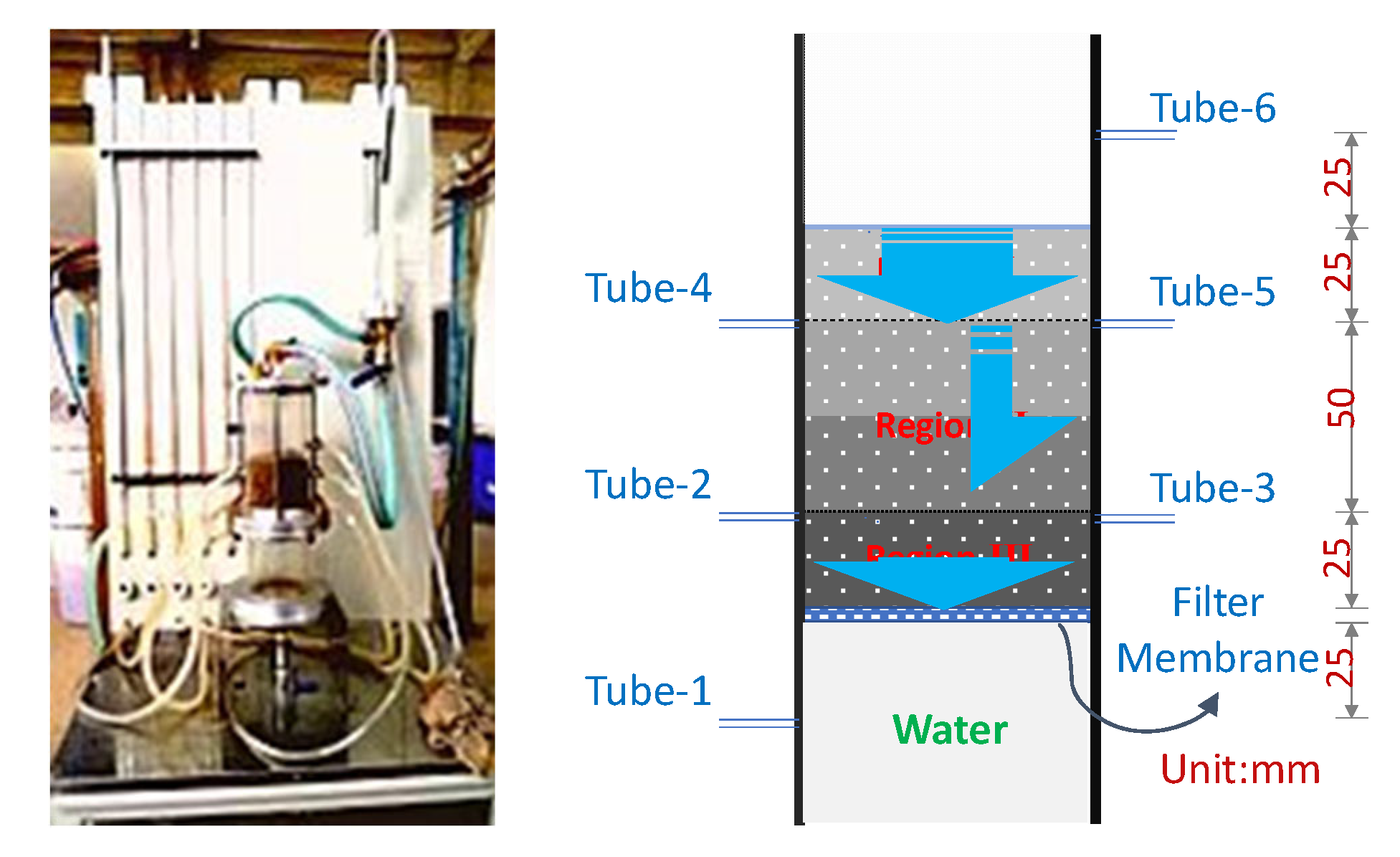
2.4.2. Experimental Scheme for Research on Clogging Behaviors of Raw-Material Drainage Boards with Different Bending Patterns
3. Test Results and Analysis of Clogging Behaviors in PVD
3.1. Analysis of Clogging Behavior of Soil-Filter Membrane System
- ①
- Region III+filter membrane XCW = 53.5 cm
- ②
- Region III+filter membrane XFW = 44.9 cm
- ③
- Region III+filter membrane ZBN = 47.8 cm
- ④
- Region III+filter membrane DBN = 37.25 cm
3.2. Analysis of Clogging Behaviors of Raw-Material Drainage Boards with Different Bending Patterns
4. Evaluation Criteria for Clogging Behaviors of PVD
4.1. Evaluation Criterion for Behaviors of PVD Filter Membranes
4.2. Evaluation Criteria for Core-Board Clogging of PVD
- ①
- Clogging evaluation criterion for filter membranes of PVD: Gradient ratio GR > 4.0.
- ②
- Clogging evaluation criterion 1 for core boards of PVD: Core board bending rate > 60% and bending angle < 45°.
- ③
- Clogging evaluation criterion 2 for core boards of PVD: Water flow reduction rate of bending drainage board > 90% or increased range of its well resistance > 9.
5. Summary
- (1)
- The gradient ratio method can be used to effectively simulate the clogging behaviors of PVD filter membranes under graded vacuum preloading. Also, in the design of graded vacuum preloading, it is important to study the suitability of filtration and drainage performance of PVD filter membranes based on their equivalent pore sizes and pore structure characteristics.
- (2)
- The buckling strength of core board grooves is a key factor influencing the water-flow reduction rates of core boards. Meanwhile, the water-flow reduction rates and increasing ranges of well resistance of core boards can be used as comprehensive indicators reflecting their clogging behaviors. Furthermore, the bending angles and bending rates of core boards can be used as specific technical indicators for judging their clogging behaviors.
- (3)
- It is proposed to apply the following criteria to evaluate the clogging behaviors of PVD.
- ①
- Clogging evaluation criterion for filter membranes of PVD: Gradient ratio GR > 4.0.
- ②
- Clogging evaluation criterion 1 for core boards of PVD: Core board bending rate > 60% and bending angle < 45°.
- ③
- Clogging evaluation criterion 2 for core boards of PVD: Water flow reduction rate of bending drainage board > 90%; or increased range of its well resistance > 9.
Author Contributions
Funding
Data Availability Statement
Conflicts of Interest
References
- Deng, Y.; Liu, L.; Cui, Y.-J.; Feng, Q.; Chen, X.; He, N. Colloid effect on clogging mechanism of hydraulic reclamation mud improved by vacuum preloading. Can. Geotech. J. 2019, 56, 611–620. [Google Scholar] [CrossRef]
- Feng, S.; Lei, H.; Wang, L.; Hao, Q. The reinforcement analysis of soft ground treated by thermal consolidation vacuum preloading. Transp. Geotech. 2021, 31, 100672. [Google Scholar] [CrossRef]
- Zhang, X.; Lu, Y.; Yao, J.; Wu, Y.; Tran, Q.C.; Vu, Q.V. Insight into conditioning landfill sludge with ferric chloride and a Fenton reagent: Effects on the consolidation properties and advanced dewatering. Chemosphere 2020, 252, 126528. [Google Scholar] [CrossRef] [PubMed]
- Xu, Y.; Wu, Y.; Zhang, X.; Chen, G.; Zhang, Y.; Ji, J. Anti-clogging mechanism of freeze-thaw combined with step vacuum preloading in treating landfill sludge. Environ. Res. 2023, 218, 115059. [Google Scholar] [CrossRef]
- Kjellman, W. Consolidation of clay soil by means of atmospheric pressure. In Proceedings of the Soil Stabilization Conference, Boston, MA, USA, 18–20 June 1952. [Google Scholar]
- Shen, S.-L.; Chai, J.-C.; Hong, Z.-S.; Cai, F.-X. Analysis of field performance of embankments on soft clay deposit with and without PVD-improvement. Geotext. Geomembr. 2005, 23, 463–485. [Google Scholar] [CrossRef]
- Saowapakpiboon, J.; Bergado, D.; Youwai, S.; Chai, J.; Wanthong, P.; Voottipruex, P. Measured and predicted performance of prefabricated vertical drains (PVDs) with and without vacuum preloading. Geotext. Geomembr. 2010, 28, 1–11. [Google Scholar] [CrossRef]
- Krishnapriya, P.; Sandeep, M.; Antony, J. Efficiency of Vacuum Preloading on Consolidation Behaviour of Cochin Marine Clay. Procedia Technol. 2016, 24, 256–262. [Google Scholar] [CrossRef]
- López-Acosta, N.; Espinosa-Santiago, A.; Pineda-Núñez, V.; Ossa, A.; Mendoza, M.; Ovando-Shelley, E.; Botero, E. Performance of a test embankment on very soft clayey soil improved with drain-to-drain vacuum preloading technology. Geotext. Geomembr. 2019, 47, 618–631. [Google Scholar] [CrossRef]
- Lu, M.; Sun, J. Analytical model for consolidation of soft ground improved by PVDs with air-boosted system. Comput. Geotech. 2022, 151, 104968. [Google Scholar] [CrossRef]
- Bao, S.; Lou, Y.; Dong, Z.; Mo, H.; Chen, P.; Zhou, R. Causes and countermeasures for vacuum consolidation failure of newly-dredged mud foundation. Chin. J. Geotech. Eng. 2014, 36, 1350–1359. (In Chinese) [Google Scholar]
- Wang, P.; Wu, J.; Ge, X.; Chen, F.; Yang, X. Non-uniform Consolidation of Soil and Influence of Corresponding Clogging Effect During Vacuum Preloading. Int. J. Geosynth. Ground Eng. 2022, 8, 58. [Google Scholar] [CrossRef]
- Le, C.; Xu, C.; Wu, X.F.; Jin, Y.W. Experimental research on clogging characteristic of two types of PVD filters. Rock Soil Mech. 2014, 35, 2529–2533. (In Chinese) [Google Scholar]
- Lei, H.; Lu, H.; Liu, J.; Zheng, G. Experimental study of the clogging of dredger fills under vacuum preloading. Int. J. Geomech. 2017, 17, 04017117. [Google Scholar] [CrossRef]
- Cai, Y.; Qiao, H.; Wang, J.; Geng, X.; Wang, P.; Cai, Y. Experimental tests on effect of deformed prefabricated vertical drains in dredged soil on consolidation via vacuum preloading. Eng. Geol. 2017, 222, 10–19. [Google Scholar] [CrossRef]
- Xu, B.H.; He, N.; Jiang, Y.B.; Zhou, Y.Z.; Zhan, X.J. Experimental Study of the Clogging of Dredger Fills under Vacuum Preloading. Geotext. Geomembr. 2020, 48, 614–624. [Google Scholar] [CrossRef]
- Shi, L.; Wang, Q.-Q.; Xu, S.-L.; Pan, X.-D.; Sun, H.-L.; Cai, Y.-Q. Numerical study on clogging of prefabricated vertical drain in slurry under vacuum loading. Granul. Matter 2018, 20, 1–14. [Google Scholar] [CrossRef]
- Shi, L.; Yin, X.; Ye, X.; He, Z.; Sun, H.; Cai, Y. Radial Filtration Model of Clogging Column for Prefabricated Vertical Drain Treatment of Slurry. J. Geotech. Geoenvironmental Eng. 2023, 149, 04022118. [Google Scholar] [CrossRef]
- Yang, P.; Tang, Y.-Q.; Wang, J.-X.; Yang, Y.; An, X. Test on consolidation of dredger fill by cube grid of plastic drain board preinstalled. Eng. Geol. 2012, 127, 81–85. [Google Scholar] [CrossRef]
- Deng, D.; Hong, Z.; Liu, C.; Ding, J.; Hong, P. Large-scale model tests on dewater of dredged clay by use of ventilating vacuum method. Yantu Gongcheng Xuebao Chin. J. Geotech. Eng. 2009, 31, 250–253. (In Chinese) [Google Scholar]
- Wang, J.; Ma, J.; Liu, F.; Mi, W.; Cai, Y.; Fu, H.; Wang, P. Experimental study on the improvement of marine clay slurry by electroosmosis-vacuum preloading. Geotext. Geomembr. 2016, 44, 615–622. [Google Scholar] [CrossRef]
- Wang, J.; Ni, J.; Cai, Y.; Fu, H.; Wang, P. Combination of vacuum preloading and lime treatment for improvement of dredged fill. Eng. Geol. 2017, 227, 149–158. [Google Scholar] [CrossRef]
- Hu, X.; Zhang, W.; Fu, H.; Wang, J.; Ni, J. Clogging effect of prefabricated horizontal drains in dredged soil by air booster vacuum consolidation. Geotext. Geomembr. 2021, 49, 1529–1538. [Google Scholar] [CrossRef]
- Peng, W.; Gu, B.; Yang, H.; Yang, X.; Yu, Z. Analysis method for consolidation of soil under vacuum preloading assisted by air booster. Mar. Georesources Geotechnol. 2022, 40, 1397–1401. [Google Scholar] [CrossRef]
- Wang, J.; Fu, H.; Zhang, W.; Ni, J.; Li, X.; Cai, Y. Effect of pressurization frequency and duration on the consolidation of a dredged soil using air booster vacuum preloading combined with prefabricated horizontal drains. Geotext. Geomembr. 2023, 51, 209–218. [Google Scholar] [CrossRef]
- Bao, S.; Dong, Z.; Mo, H.; Wang, D. Laboratory research on new improvement technology of newly hydraulic reclamation mud with high clay content II. Zhejiang da xue xue bao. Gong Xue Ban 2015, 36, 61–67. (In Chinese) [Google Scholar]
- ASTM D6917-16; Standard Guide for Selection of Test Methods for Prefabricated Vertical Drains (PVD). ASTM: West Conshohocken, PA, USA, 2022.
- ASTM D5101-12; Standard Test Method for Measuring the Filtration Compatibility of Soil-Geotextile Systems. ASTM: West Conshohocken, PA, USA, 2023.
- ASTM D6918-09; Standard Test Method for Testing Vertical Strip Drains in the Crimped Condition. ASTM: West Conshohocken, PA, USA, 2022.
- Fannin, R.J.; Vaid, Y.P.; Shi, Y. A critical evaluation of the gradient ratio test. Geotech. Test. J. 1994, 17, 35–42. [Google Scholar]
- Cai, Y.Q. Consolidation mechanism of vacuum preloading for dredged slurry and anti-clogging method for drains. Chin. J. Geotech. Eng. 2021, 43, 201–225. (In Chinese) [Google Scholar]

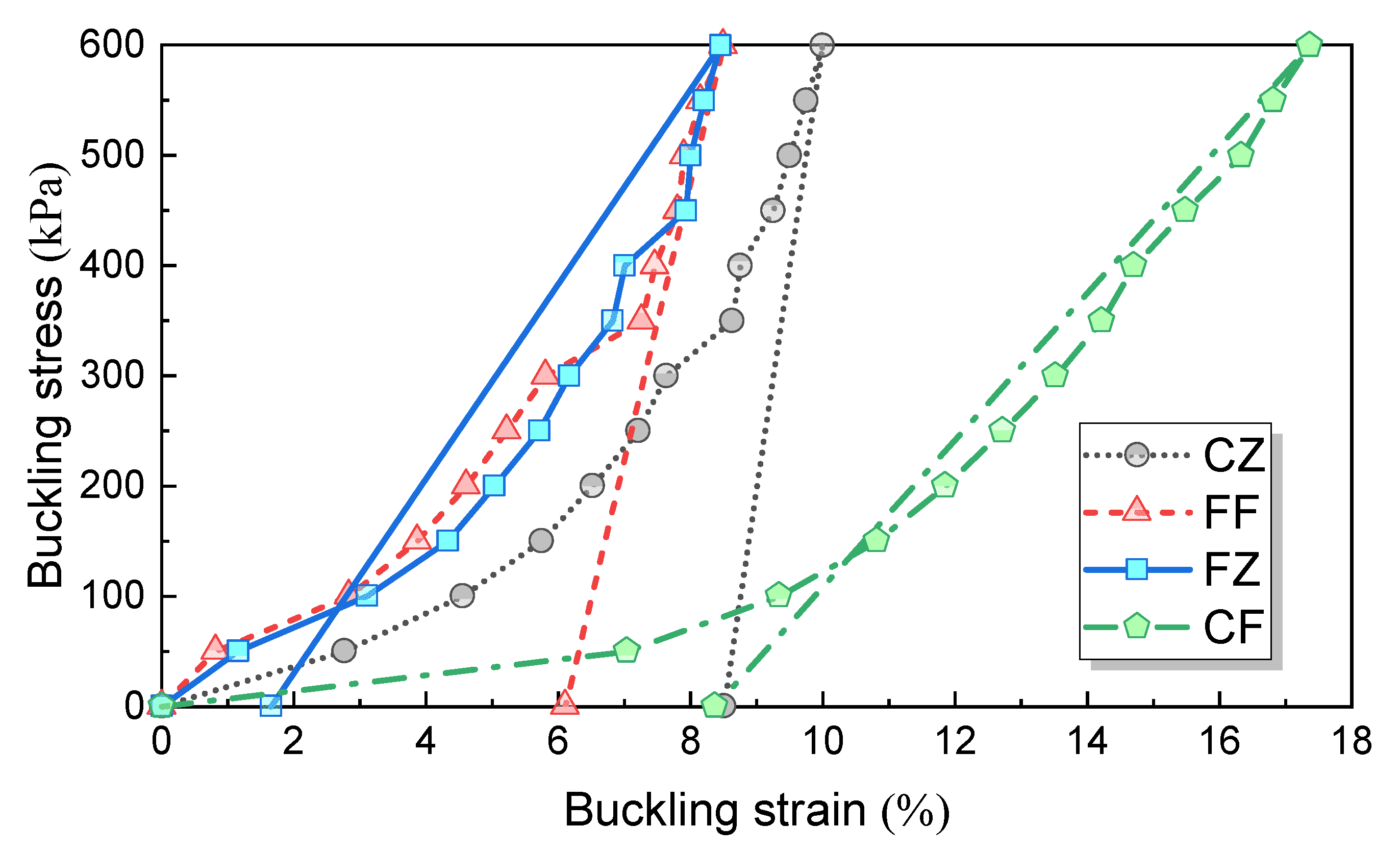
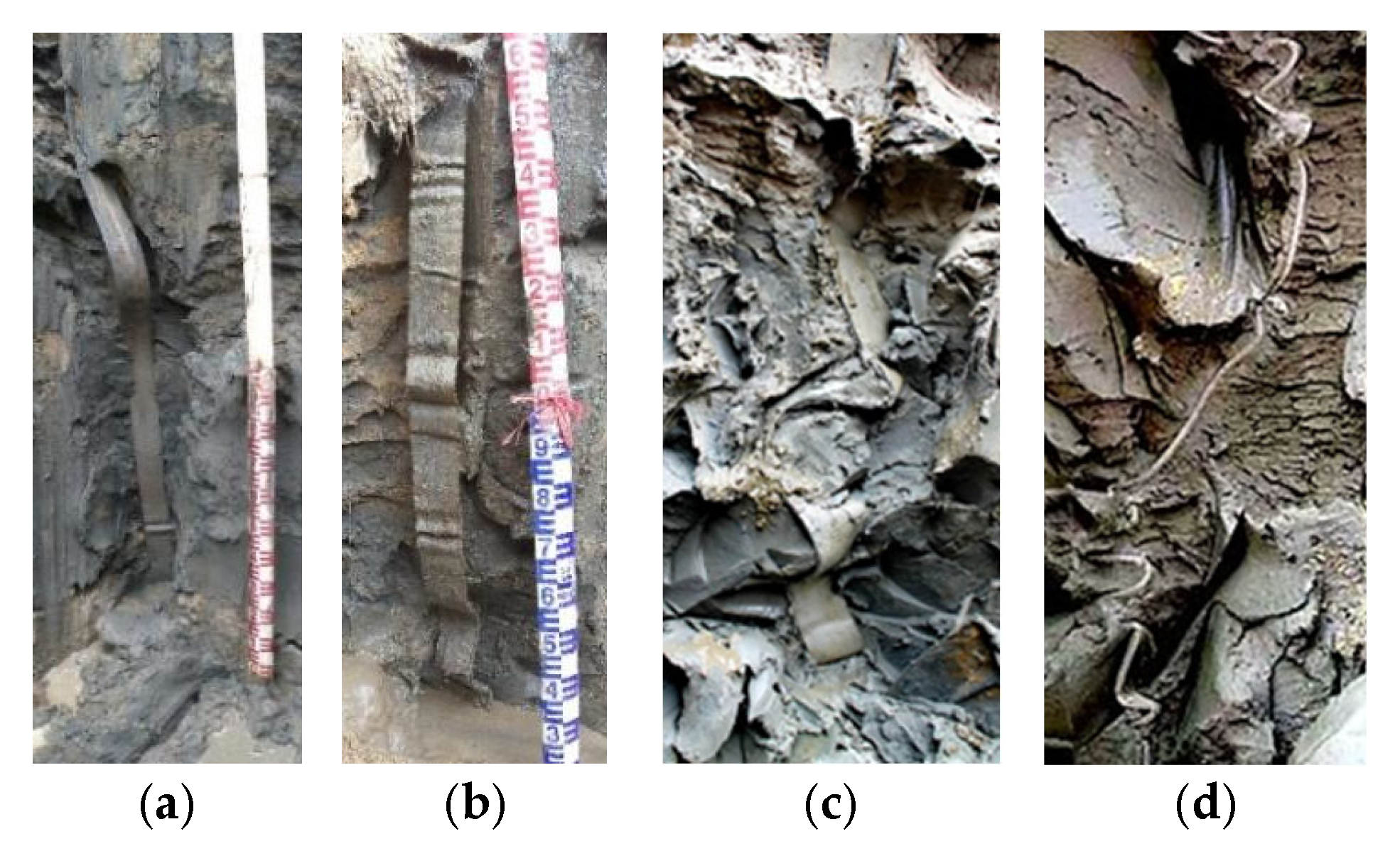
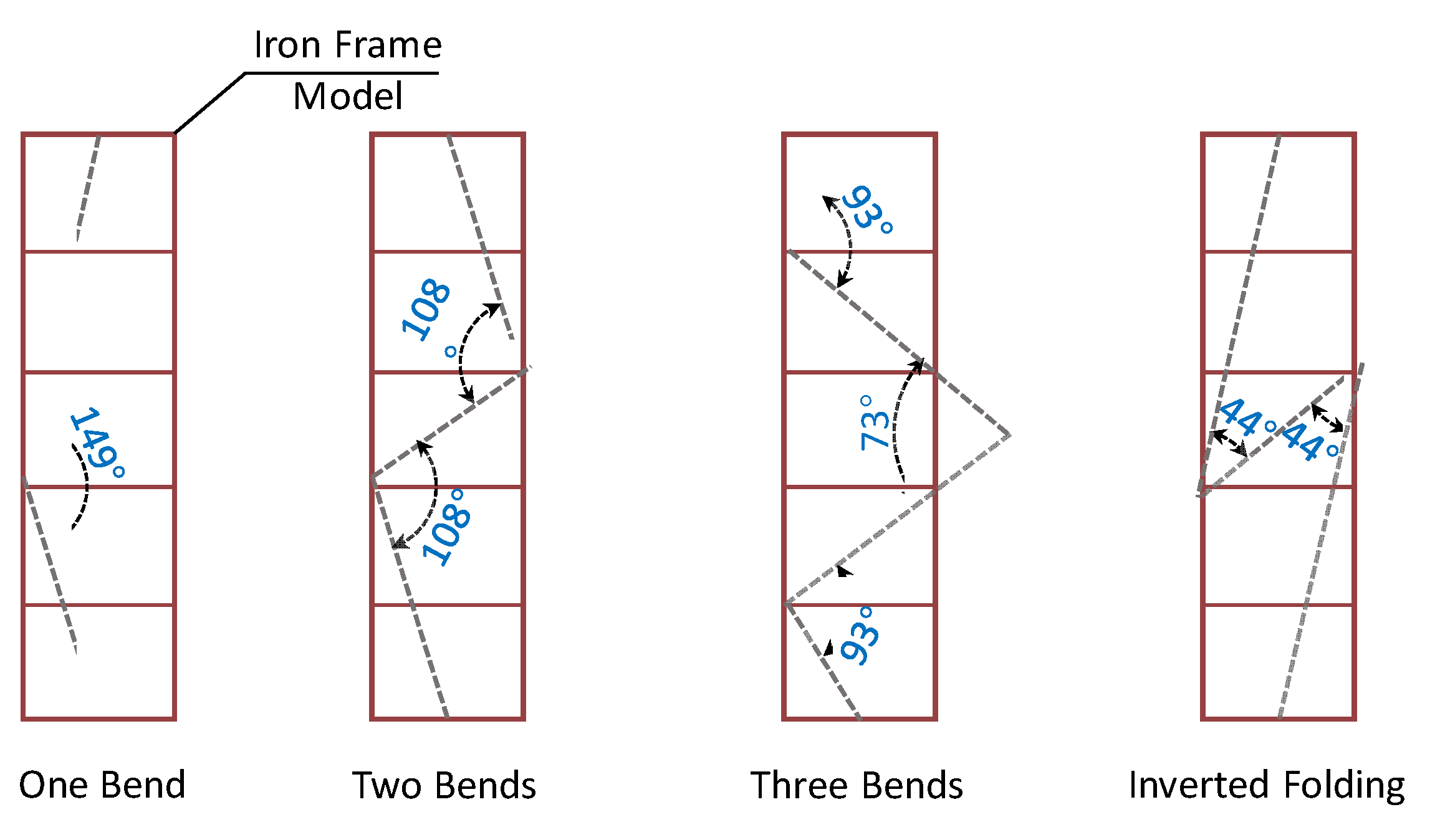
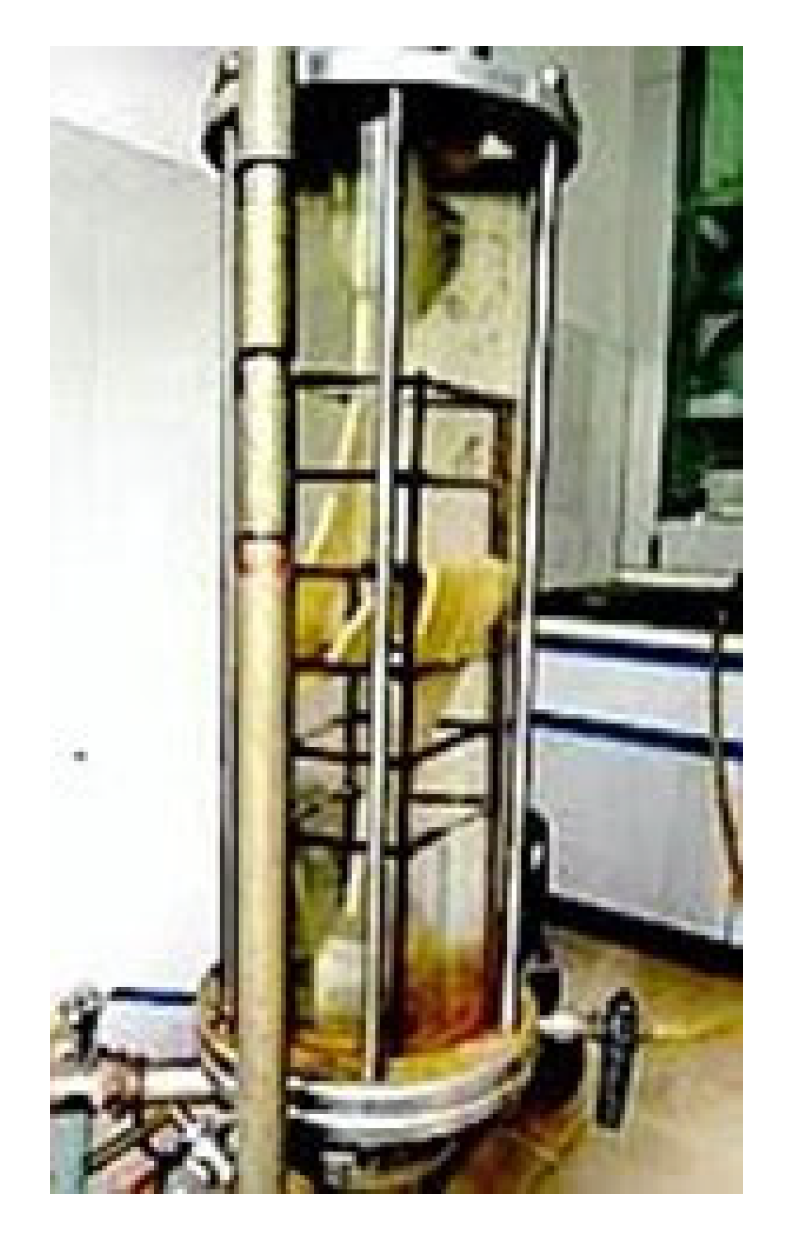
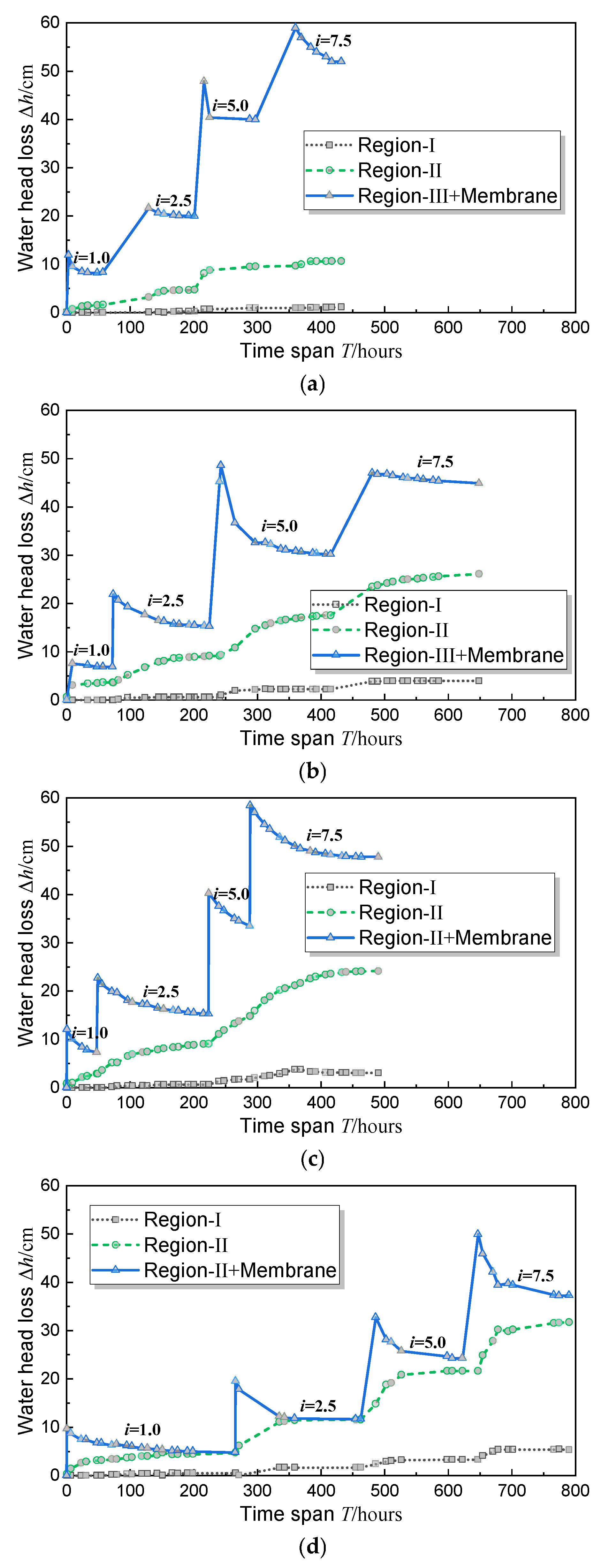

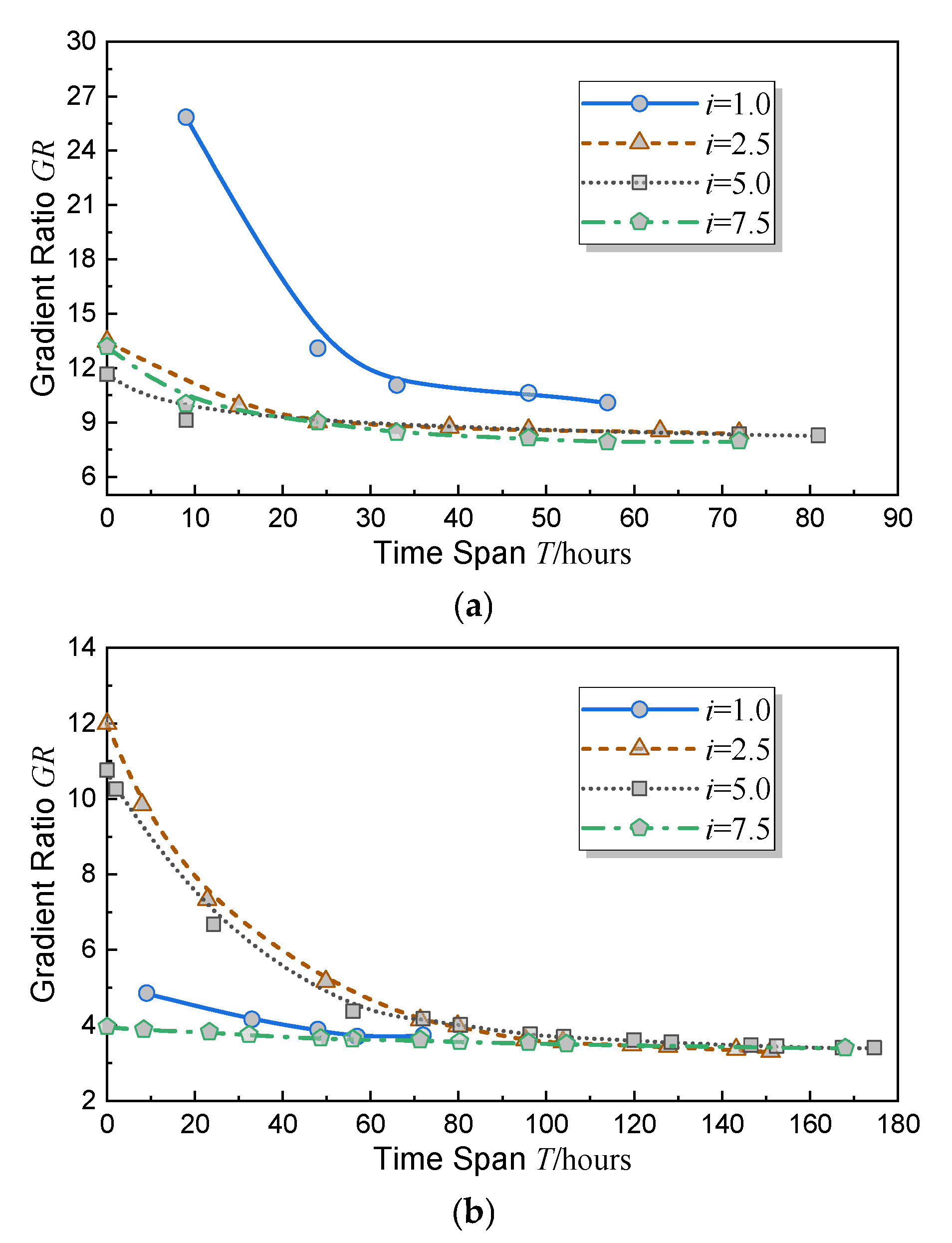
| Sample Number | Fiber Diameter df//μm | Fiber Layer Number m | Equivalent Pore Size O95/mm | Porosity ng/% | Permeability Coefficient kg/cm/s | ||
|---|---|---|---|---|---|---|---|
| DBN | 63 (Vertical)/ 127 (Horizontal) | 1 | 0.18 × 0.25 (Rectangle) | 79.0 | 0.0455 | ||
| ZBN | 54 (Vertical)/ 61 (Horizontal) | 1 | 0.12 × 0.12 (Rectangle) | 68.9 | 0.0359 | ||
| XCW | 14.2 | 12 | 0.047 (Equivalent round) | 76.3 | 0.0089 | ||
| XFW | 11.5 | 14 | 0.049 (Equivalent round) | 79.8 | 0.0250 | ||
| Mechanical properties of typical geomembranes | |||||||
| Sample Number | Test Condition | Constant Strain Load (10%) N | Tensile Strength (10%) N/cm | Constant Strain Load (15%) N | Tensile Strength (15%) N/cm | Maximum Force N | Elongation at Break/% |
| XCW | Dry | 151.75 | 25.29 | 170.25 | 28.38 | 176.50 | 16.50 |
| Wet | 94.64 | 15.77 | 95.51 | 15.92 | 102.38 | 14.09 | |
| XFW | Dry | 166.50 | 27.75 | 189.59 | 31.60 | 275.46 | 35.47 |
| Wet | 125.43 | 20.90 | 142.28 | 23.71 | 181.19 | 31.74 | |
| DBN | Wet | 80.56 | 13.43 | 137.94 | 22.99 | 408.57 | 45.06 |
| ZBN | Wet | 51.23 | 8.54 | 86.24 | 14.37 | 311.53 | 41.62 |
| Quantitative Index | Vertical | One Bend | Two Bends | Three Bends | Inverted Folding |
|---|---|---|---|---|---|
| Bending angle 1/° | 180 | 149 | 108 | 93 | 44 |
| Bending angle 2/° | 180 | - | 108 | 73 | 44 |
| Bending angle 3/° | 180 | - | - | 93 | - |
| Effective length/cm | 40 | 42 | 49 | 52 | 64 |
| Bending ratio/% | 0 | 5 | 22.5 | 30 | 60 |
| Test Sample | Bending Pattern | ||||
|---|---|---|---|---|---|
| Vertical | One Bend | Two Bends | Three Bends | Inverted Folding | |
| CF | 151.40 | 151.17 | 110.11 | 100.85 | 96.29 |
| CZ | 247.52 | 246.91 | 246.00 | 245.37 | 221.07 |
| FF | 221.98 | 221.84 | 221.47 | 218.86 | 202.96 |
| FZ | 234.47 | 232.97 | 232.14 | 231.32 | 215.38 |
| Test Sample | Bending Rate | ||||
|---|---|---|---|---|---|
| 0% | 5% | 22.5% | 30% | 60% | |
| CF | 0.00% | 0.15% | 27.27% | 33.39% | 36.40% |
| CZ | 0.00% | 0.25% | 0.61% | 0.87% | 10.69% |
| FF | 0.00% | 0.06% | 0.23% | 1.41% | 8.57% |
| FZ | 0.00% | 0.64% | 0.99% | 1.34% | 8.14% |
| Water-flow reduction rates of test samples under different bending angles | |||||
| 180° | 149° | 108° | 86.3° | 44° | |
| CF | 0.00% | 0.15% | 13.64% | 11.13% | 18.20% |
| CZ | 0.00% | 0.25% | 0.31% | 0.29% | 5.34% |
| FF | 0.00% | 0.06% | 0.11% | 0.47% | 4.28% |
| FZ | 0.00% | 0.64% | 0.50% | 0.45% | 4.07% |
| Test Sample | Bending Rate | ||||
|---|---|---|---|---|---|
| 0% | 5% | 22.5% | 30% | 60% | |
| CF | 0.00% | 0.15% | 37.50% | 50.12% | 57.23% |
| CZ | 0.00% | 0.25% | 0.62% | 0.88% | 11.96% |
| FF | 0.00% | 0.06% | 0.23% | 1.43% | 9.37% |
| FZ | 0.00% | 0.64% | 1.00% | 1.36% | 8.86% |
| Increases in well resistance of test samples with different bending angles | |||||
| Test Sample | Bending Angle/° | ||||
| 180° | 149° | 108° | 86.3° | 44° | |
| CF | 0.00% | 0.15% | 18.75% | 16.71% | 28.62% |
| CZ | 0.00% | 0.25% | 0.31% | 0.29% | 5.98% |
| FF | 0.00% | 0.06% | 0.11% | 0.48% | 4.68% |
| FZ | 0.00% | 0.64% | 0.50% | 0.45% | 4.43% |
Disclaimer/Publisher’s Note: The statements, opinions and data contained in all publications are solely those of the individual author(s) and contributor(s) and not of MDPI and/or the editor(s). MDPI and/or the editor(s) disclaim responsibility for any injury to people or property resulting from any ideas, methods, instructions or products referred to in the content. |
© 2023 by the authors. Licensee MDPI, Basel, Switzerland. This article is an open access article distributed under the terms and conditions of the Creative Commons Attribution (CC BY) license (https://creativecommons.org/licenses/by/4.0/).
Share and Cite
Bao, S.; Guo, L.; Dong, Z.; Zhou, R.; Zhou, S.; Chen, J. Clogging Behaviors in PVD and Their Evaluation Criteria for Dredged Mud Slurry. Water 2023, 15, 4206. https://doi.org/10.3390/w15244206
Bao S, Guo L, Dong Z, Zhou R, Zhou S, Chen J. Clogging Behaviors in PVD and Their Evaluation Criteria for Dredged Mud Slurry. Water. 2023; 15(24):4206. https://doi.org/10.3390/w15244206
Chicago/Turabian StyleBao, Shufeng, Lingfeng Guo, Zhiliang Dong, Ruibo Zhou, Shuangxi Zhou, and Jian Chen. 2023. "Clogging Behaviors in PVD and Their Evaluation Criteria for Dredged Mud Slurry" Water 15, no. 24: 4206. https://doi.org/10.3390/w15244206





